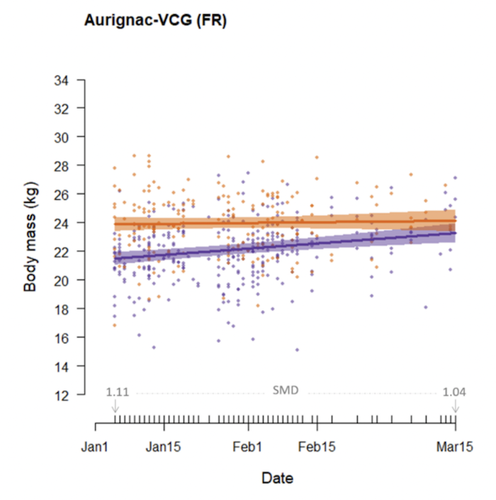
MCLOUGHLIN Philip
Recommendations: 0
Review: 1
Review: 1

Body mass change over winter is consistently sex-specific across roe deer (Capreolus capreolus) populations
Is it sexual mass dimorphism season?
Recommended by Denis Réale based on reviews by Patrick Bergeron, Philip McLoughlin and Achaz von HardenbergPolygyny is assumed to have led to the evolution of strong sexual size dimorphism (SSD) in mammals, males often being heavier or showing more developed armaments than females (Weckerly 1998; Loison et al. 1999; Pérez‐Barbería et al. 2002). SSD generally increases with the degree of polygyny of the species. However, the degree of SSD, and particularly of sexual mass dimorphism, is not fixed for each species, and differences exist between populations (Blanckenhorn et al. 2006; Cox & Calsbeek 2010) or even between seasons within populations (Rughetti & Festa‐Bianchet 2011).
In this study, Hewison et al. propose that studying seasonal variation in sexual mass dimorphism and how this can be affected by winter harshness and latitude allows us to better assess the energetic costs associated with the eco-evolutionary constraints acting on each sex. To achieve their goal, Hewison et al. use a formidable, long-term dataset of over 7,000 individuals, in five roe deer populations (Capreolus capreolus), from south-west France and Sweden.
According to the authors, sexual mass dimorphism should be at its lowest in early spring in this species due to a stronger trade-off between antler growth and body weight maintenance in males over winter than in females. Furthermore, harsher conditions, varying both in time and space (i.e., Sweden vs. France), should increase winter weight loss, and thus, mass change differences between the sexes should be stronger and show more variation in Sweden than in France.
Their results support their hypotheses. In the two Swedish populations, males lost more mass than females. In the three French populations, males maintain their body mass while females gain some over the winter. Because of these sex-dependent loss/gain in body mass, sexual dimorphism was stronger early in the winter and null at the onset of spring. Furthermore, sexual dimorphism was stronger in southern than in northern populations. In France, males weighed about 10% more than females, while they weighed about 5% more in Sweden. Roe deer, however, do not show any dimorphism early in the spring, when males start defending their territory.
The authors also found more variation in mass change among years in Swedish than in French roe deer, suggesting a stronger effect of winter severity on the dynamics of mass change in northern than in southern populations. The authors interpret the decrease in sexual dimorphism throughout the winter by the fact that, during this period, the energetic cost paid by males associated with the growth of their antlers and the effort of establishing their mating territory. They thus attribute the greater mass change in males to the competitive allocation of resources to antler growth or body mass. They also discuss the low probability that such sex differences in mass change could be caused by females’ gestation in this species.
Interestingly, Hewison et al. found that individual differences represented more than 70% of the total variation in body mass, and the low estimated among-individual variance in slopes with time might indicate that, despite a lower SSD, selection pressures on body mass can still be maintained at times when body mass may play an important role, such as in spring with territorial defense or later during mating (Vanpé et al. 2010).
I recommend this article because it produces strong results, which show, without a shadow of a doubt, sex differences in their seasonal mass changes, resulting in a marked seasonal variation in SSD. The differences observed between southern and northern populations confirm the idea that the severity of the winters endured by these populations acts as a constraint on the deer's patterns of mass change. I hope this study will encourage more examinations of how eco-evolutionary constraints affect the sexual size dimorphism.
References
Blanckenhorn, W. U., Stillwell, R. C., Young, K. A., Fox, C. W., & Ashton, K. G. (2006). When Rensch meets Bergmann: does sexual size dimorphism change systematically with latitude? Evolution, 60(10), 2004-2011. https://doi.org/10.1554/06-110.1
Cox, R. M., & Calsbeek, R. (2010). Sex-specific selection and intraspecific variation in sexual size dimorphism. Evolution, 64(3), 798-809. https://doi.org/10.1111/j.1558-5646.2009.00851.x
Hewison M, Bonnot N, Gaillard JM, Kjellander P, Lemaitre J-F, Morellet N. and Pellerin M (2024) Body mass change over winter is consistently sex-specific across roe deer (Capreolus capreolus) populations. bioRxiv, ver.4 peer-reviewed and recommended by PCI Ecology https://doi.org/10.1101/2022.09.09.507329
Loison, A., Gaillard, J. M., Pélabon, C., & Yoccoz, N. G. (1999). What factors shape sexual size dimorphism in ungulates? Evolutionary Ecology Research, 1(5), 611-633. https://www.evolutionary-ecology.com/issues/v01n05/jjar1019.pdf
Pérez‐Barbería, F. J., Gordon, I. J., & Pagel, M. (2002). The origins of sexual dimorphism in body size in ungulates. Evolution, 56(6), 1276-1285. https://doi.org/10.1111/j.0014-3820.2002.tb01438.x
Rughetti, M., & Festa‐Bianchet, M. (2011). Seasonal changes in sexual size dimorphism in northern chamois. Journal of Zoology, 284(4), 257-264. https://doi.org/10.1111/j.1469-7998.2011.00800.x
Vanpé, C., Gaillard, J. M., Kjellander, P., Liberg, O., Delorme, D., & Hewison, A. M. (2010). Assessing the intensity of sexual selection on male body mass and antler length in roe deer Capreolus capreolus: is bigger better in a weakly dimorphic species? Oikos, 119(9), 1484-1492. https://doi.org/10.1111/j.1600-0706.2010.18312.x
Weckerly, F. W. (1998). Sexual-size dimorphism: influence of mass and mating systems in the most dimorphic mammals. Journal of Mammalogy, 79(1), 33-52. https://doi.org/10.2307/1382840